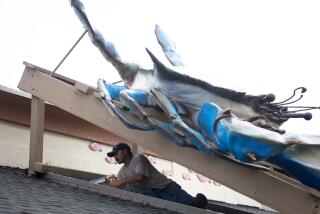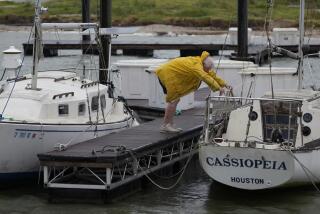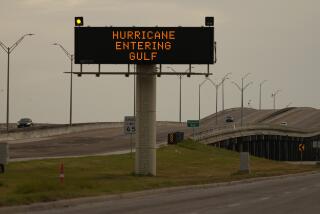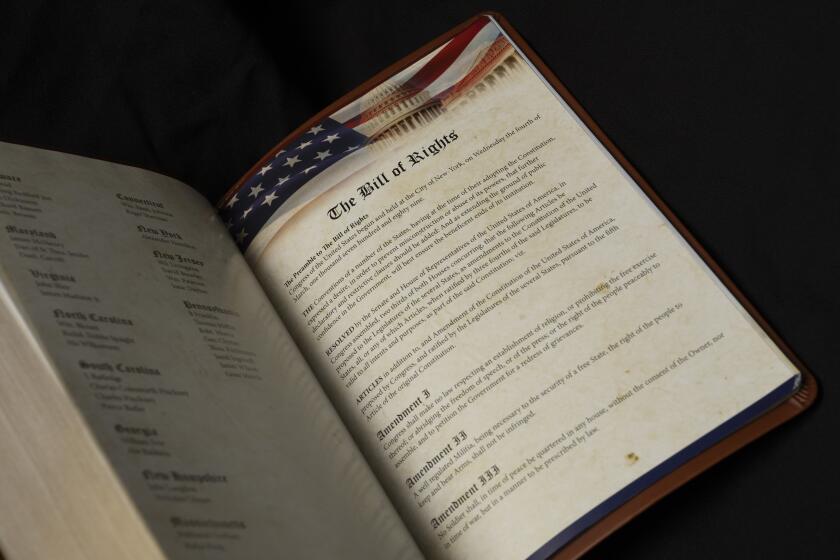Ships return to gulf spill site as storm fizzles
Reporting from Los Angeles and Grand Isle, La.
The fleet tending the blown-out BP well headed back to the oil spill site Saturday after a tropical storm system fizzled, eliminating the threat of dangerously high seas.
What had been Tropical Storm Bonnie had so weakened by Saturday afternoon that it could barely muster maximum sustained winds of 30 mph, too feeble to generate much of a storm surge by the time it reached the northern Gulf of Mexico.
The modest ocean turbulence could do some good by flushing beaches and breaking up surface slicks and oil patches. “It’s expected to break tar patches and tar mats into smaller tar balls, which means faster weathering and faster natural biodegradation,” said Jane Lubchenco, administrator of the National Oceanic and Atmospheric Administration.
Waves could also drive some oil into marshes and bayous, but federal officials said coastal residents will not be showered with blowing crude. “Fears of raining oil are unfounded,” Lubchenco said in a Saturday telephone call with reporters.
The small fleet of response vessels that had been evacuated from the well site Friday was ordered back, including the rigs that are drilling two relief wells that will be used to try to permanently plug the bottom of the damaged well with heavy drilling mud and cement.
Retired Adm. Thad Allen, who is overseeing the federal spill response, said it would take 24 to 36 hours for the rig drilling the main relief hole to return and reconnect its drill pipe. After that, casing pipe will be laid and cemented into the relief well.
While the cement is drying, BP will proceed with a “static kill” procedure to cork the top of the original well, a step that is expected to aid the final plugging of the well’s bottom. All told, Allen predicted, it would be at least a week before the relief-well drilling reaches the original well bore.
In the meantime, the spill, which for three months poured an estimated 35,000 to 60,000 barrels a day into the gulf, has been stopped with a mechanical well cap installed more than a week ago. The cap remained shut during the storm evacuation, and Allen said two underwater robots stayed at the well site to continue surveillance.
Pressure in the cap has continued to rise slowly, giving scientists greater confidence that oil is not seeping from the well beneath the seabed, a situation that could have made the largest offshore oil spill in U.S. history even harder to contain.
On Grand Isle, Louisiana’s only inhabited barrier island, a few sport fishermen took advantage of the calm before Bonnie hit, casting their lines into waters recently reopened to fishing.
Raishde Thompson, 34, of Slidell, La., was having a rough morning. As thunderclouds loomed in the distance, he reeled in a small baby catfish.
“All day, man. All day. Then everything you catch, there’s nothing but catfish.... I think they’re just able to adapt to anything,” Thompson said, affixing bait of a headless shrimp to his line. “Ain’t no reds. Ain’t no trout. I wonder where they went.”
Thompson said that before the BP spill, he could catch his day’s limit of six redfish within several hours. But between 7 a.m. and noon, he had snagged only one redfish.
“Now, it’s taking all day to get one or two,” Thompson lamented. “We won’t get any good fishing for years. Pretty depressing, you know? What can you do?”
Boxall reported from Los Angeles and Lin reported from Grand Isle.
More to Read
Sign up for Essential California
The most important California stories and recommendations in your inbox every morning.
You may occasionally receive promotional content from the Los Angeles Times.












